Before we can go “beyond human,” we must first consider what it is we’re going beyond. Scientific knowledge of animal intelligence, or of any aliens or AIs we may someday encounter, can only be interpreted through the lens of human experience. How should we regard such beings? As inferiors, superiors, or equals? How ought we treat them? What do they imply about our own place in the universe?
The impact of such questions, and the answers we give, depend on our worldview. Different cultures have produced widely divergent worldviews, from those which exalt humans as the masters of creation, to those in which humans are merely one small part of an interconnected whole. In this section, we present four major worldviews that have powerfully shaped modern perspectives on human existence and our relationship with other creatures.
(Note: most images in this exhibit are interactive, and can be clicked to enlarge or reveal further information on the subject matter)
Children of the Earth

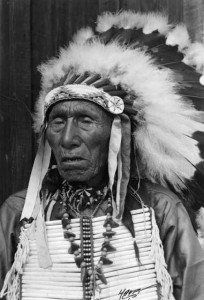
Indigenous American peoples span a range of two continents, across an enormous variety of natural conditions. Accordingly, there is no such thing as a singular “Native American worldview.” That said, the interconnection of all living things is a theme common to most Native American cultures. Many traditions regard all life as sharing a common origin or spiritual essence. Creation stories often describe a primordial time in which the boundaries between different species were not fixed, and humans, animals, and other beings could transform into one another’s forms. Certain animals are widely revered as important agents in the creation of the world.
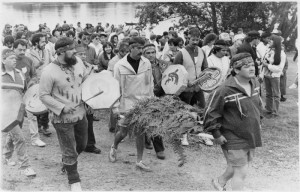
As humans are considered part of the natural world, most Native cultures teach the importance of respect for our fellow creatures. In general, it is seen as better to adapt one’s own lifestyle to the conditions of one’s environment than to modify the environment to suit oneself. Native Americans have historically relied on hunting animals for food. However, many cultures also teach values like killing as few animals as necessary, using every part of each animal, and thanking and repaying them through rituals of gratitude.
!["The personhood of animals, their self-determination and our regret at their death, all show that choosing not to ask for their sacrifice is a legitimate Mi'kmaq option. ... With the adoption of a vegetarian or vegan diet our meal preparation and consumption can become infused with transcendent significance, as we recall our connection with other animals, our shared connection to the creator and prefigure a time when we can live in harmony with the animals, as Kluskap [the first man in Mi'kmaq mythology] did before the invention of hunting." (Dr. Margaret Robinson - photo courtesy Margaret Robinson)](https://animalpeopleforum.org/beyondhuman/wp-content/uploads/2015/03/Margaret-Robinson.png)
Such principles have not always been strictly followed. Archaeology reveals evidence of massive bison kills in which most of the meat went to waste, and many Native cultures have practiced destructive “slash and burn” agriculture. After centuries of European conquest, most Native people today depend on Western industrial agriculture for the majority of their food.
However, many tribes now offer programs to reteach traditional methods of hunting and gathering, and have revived traditional rituals to honor animals killed for food. Some Native thinkers promote vegetarian or vegan diets instead, arguing that given the modern option of a plant-based diet, it is more respectful not to kill animals at all than to do so unnecessarily. This has prompted heated debate within the Native community. Hunting and fishing are widely regarded as important cultural practices, and have historically been restricted by non-Native governments as a form of discrimination.
Native American worldviews teach that all life is important and connected. Humans may use other creatures for our needs, but should always treat them with care and respect.
The Wheel of Becoming
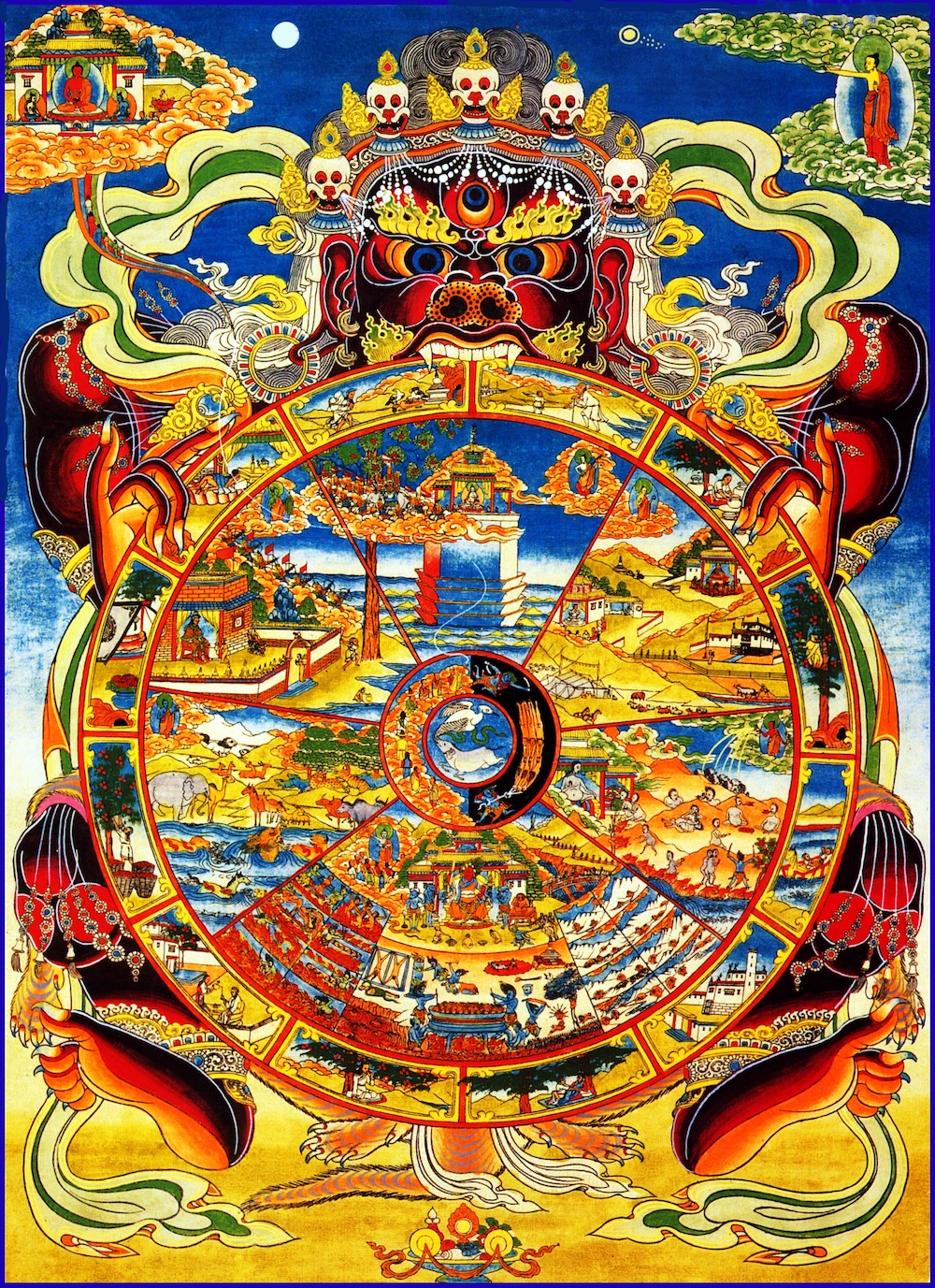
The Dharmic religions, including Hinduism, Buddhism, and Jainism, share a common origin and many core concepts. All three believe that humans, animals, and other creatures are part of a common process of life, death, and rebirth. This process is driven by karma, the spiritual fruits of one’s actions, which decide whether one is born in a higher or lower form in the next life.
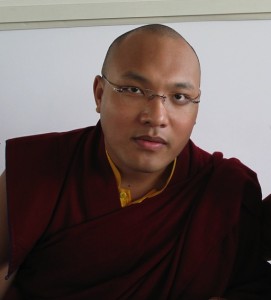
Some lives may be very long and pleasant, but all are ultimately temporary. Not even gods are truly immortal, although their lives may last countless trillions of years. With death comes the risk of a lower, more painful rebirth. For this reason, all Dharmic religions promote escape from rebirth, or enlightenment, as their highest spiritual goal.
!["From the earliest literature of the Hindus, the concept of ahimsa – non-violence in thought and deed – has been the goal of an evolved and superior person. ... Killing animals and eating meat were considered to be such heinous sins that neither prayer nor pilgrimage nor bathing in holy rivers could absolve the killer. … Sacrifice is mentioned in certain works. The catholicism of Hinduism resulted in the absorption of different deities and primitive local religions, along with their rituals. Thus many village gods and goddesses of India, who do not belong to the Vedic pantheon, joined the extended Hindu family of gods, bringing with them primitive forms of worship, such as animal sacrifice. But these were abhorred. Adi Shankara, in the seventh-eighth centuries CE... stopped animal sacrifice wherever he travelled, converting primitive deities to the pure ancient religion of the Vedas and Upanishads [the founding texts of Hinduism]." (Dr. Nanditha Krishna, e-mail correspondence – photo courtesy Nanditha Krishna)](https://animalpeopleforum.org/beyondhuman/wp-content/uploads/2015/04/Nanditha-Krishna-FB-300x254.jpg)
Humans, as the most intelligent animal, have the greatest capacity to seek enlightenment. In this sense, we are spiritually superior to other earthly creatures. However, to the extent that all forms of life are part of the same cycle of rebirth, all are equal in spiritual importance and potential.
For this reason, the Dharmic religions promote compassion for all life. However, they vary in how strictly they apply this teaching. At one end of the spectrum, some Hindus practice animal sacrifice, in the belief that pleasing their gods will outweigh any bad karma from killing animals. On the other, Jainism, Buddhism, and many schools of Hinduism forbid animal sacrifice, and often encourage or require a vegetarian diet.
Hinduism, Buddhism, and Jainism teach that all sentient beings are part of the same cycle of rebirth. Humans should treat other life forms with compassion.
The Great Chain of Being
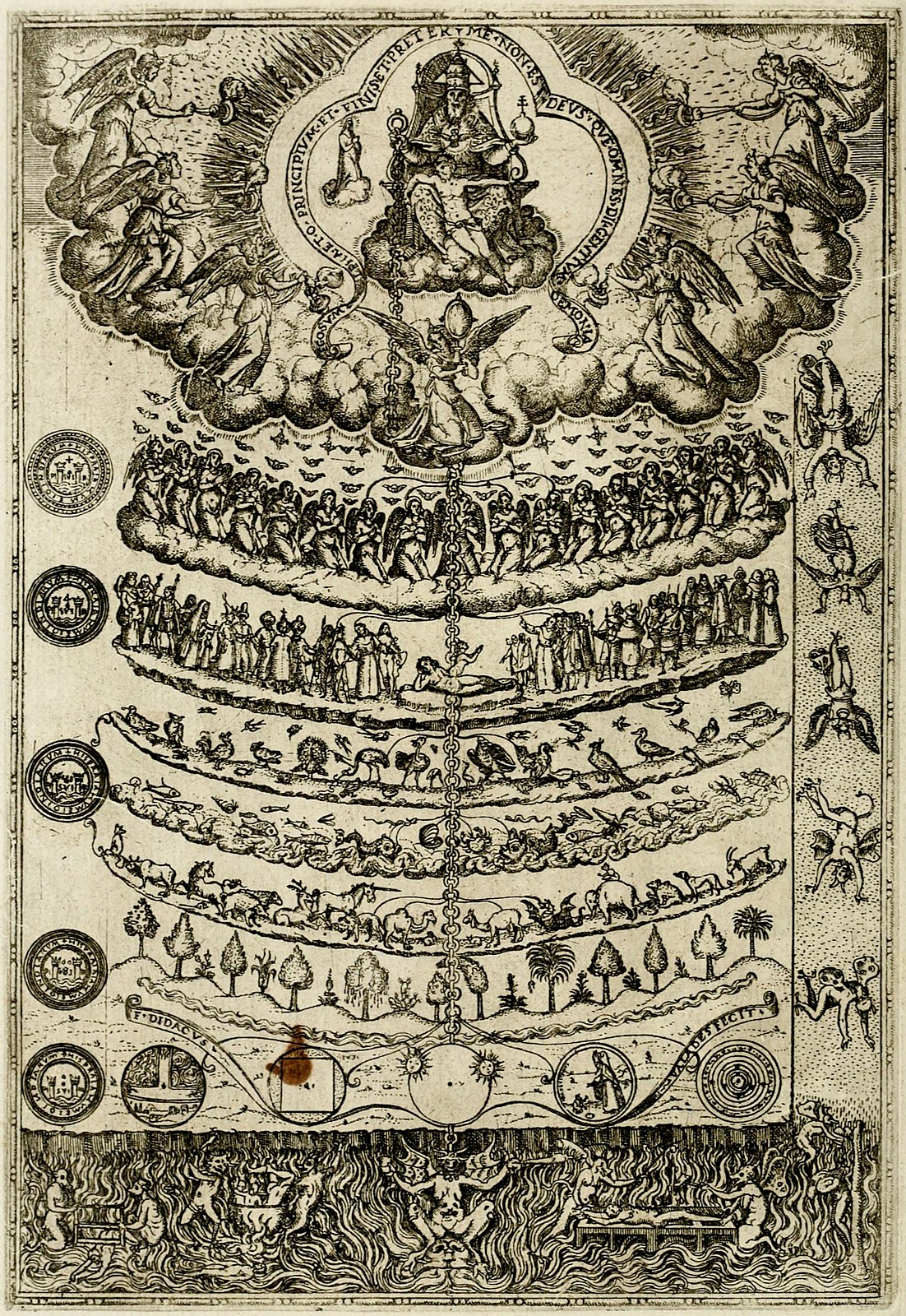

The Great Chain of Being, as conceived by medieval Christian theologians, typifies the strongly hierarchical view of Western cultures. It draws from two primary sources. One is the Greek philosopher Aristotle (384-322 BCE). Aristotle taught that of all living creatures, only humans possessed a rational soul, allowing us to think and reflect. The other source is the Bible. In the book of Genesis, God creates humans in His own image, granting us “dominion” over all other living beings.
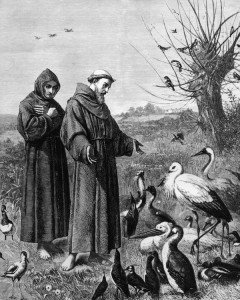
Medieval theology brought the Bible and teachings of Aristotle together into a single worldview. The Great Chain of Being affirms humans’ absolute superiority over other animals, and right to use animals for our own needs and wants. However, it does not necessarily permit deliberate cruelty, and some medieval Christians, including St. Francis, broke with the Chain in their own views of other creatures.
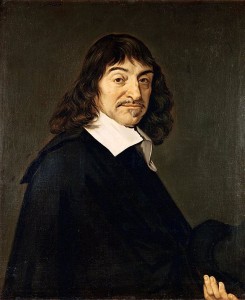
The Great Chain of Being was influential for early modern scientists, including René Descartes (1596-1650). Like theologians before him, Descartes held that humans alone were capable of reason. Animals were merely natural automata, machines operating by purely physical principles, devoid of a mind or soul. He promoted vivisection, the dissection of live animals, arguing that they did not suffer, merely react mechanically to injury.
As centuries passed, science gradually broke with theology in nearly all respects. But through Descartes, the Great Chain of Being continued to inform scientific views on animals well into the 20th century.
The Great Chain of Being portrays humans as unique and superior to other living things. Animals’ lives do not matter, and humans may use them freely however we desire.
The Tree of Life


Versions of evolutionary theory, the idea that humans and other beings share a common natural origin, have arisen in various cultures through history. In his Book of Animals, the Arabic scholar Abu Uthman al-Jahiz (776-868/9) proposed a theory much like Darwinian natural selection. In East Asia, Confucian thinkers described the natural emergence of all life from matter and energy. In the West, early modern biologists such as Carl Linnaeus (1707-1778) and Jean-Baptiste Lamarck (1744-1829) classified humans as part of the animal kingdom, and theorized that we evolved from other species.
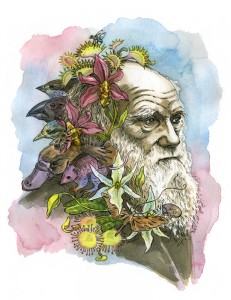
The most revolutionary figure, however, is of course Charles Darwin (1809-1882). His theory of evolution by natural selection holds that organisms naturally vary in body and behavior. Those with traits beneficial in a given environment are more likely to survive and reproduce, passing their traits on to their offspring. Over time, this leads to the appearance of new species.
Evidence from paleontology and genetic research has confirmed Darwin’s theory many times over. Evolution by natural selection is now universally accepted by scientists as the correct explanation for the diversity of life on Earth.
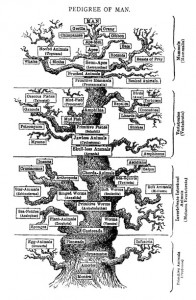
Darwin’s theory challenged the Great Chain of Being in two important ways. First, if all organisms evolved naturally, then humans are not inherently superior to other living things, which are equally well adapted to their own conditions. Second, if humans descended from other animals, then all of our abilities – mental and emotional as well as physical – should be found to some degree in other species as well.
Nonetheless, even as scientists came to accept Darwinian evolution, many still followed Descartes’ view that humans were unique and superior to other creatures. It wasn’t until well into the 20th century that scientists in general began to seriously consider that humans might share more with other species than just a distant common ancestor.
By the theory of evolution, all life on Earth shares a common origin. Humans are neither unique nor superior, for all creatures are equally evolved.
NEXT:
